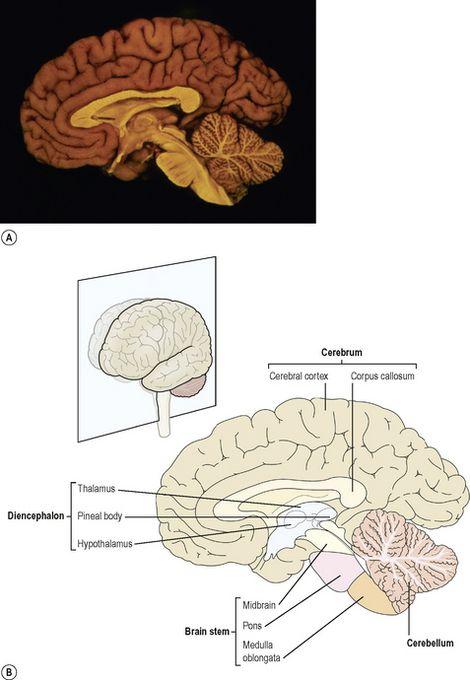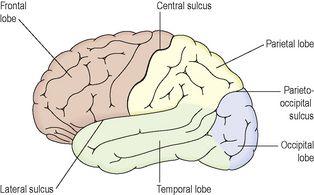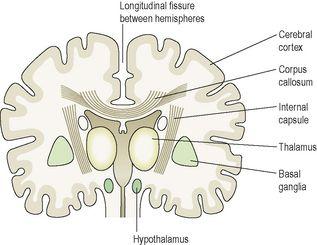Ross & Wilson Anatomy and Physiology in Health and Illness (69 page)
Read Ross & Wilson Anatomy and Physiology in Health and Illness Online
Authors: Anne Waugh,Allison Grant
Tags: #Medical, #Nursing, #General, #Anatomy

The brain constitutes about one-fiftieth of the body weight and lies within the cranial cavity. The parts are (
Fig. 7.18
):
•
cerebrum


•
cerebellum.

Figure 7.18
Section of the brain showing main parts.
Blood supply to the brain
The circulus arteriosus and its contributing arteries (see
Fig. 5.33
,
p. 96
) play a vital role in maintaining a constant supply of oxygen and glucose to the brain when the head is moved and also if a contributing artery is narrowed. The brain receives about 15% of the cardiac output, approximately 750 ml of blood per minute. Autoregulation keeps blood flow to the brain constant by adjusting the diameter of the arterioles across a wide range of arterial blood pressure (about 65–140 mmHg) with changes occurring only outside these limits.
Cerebrum
This is the largest part of the brain and it occupies the anterior and middle cranial fossae (see
Fig. 16.11
,
p. 388
). It is divided by a deep cleft, the
longitudinal cerebral fissure
, into
right
and
left cerebral hemispheres
, each containing one of the lateral ventricles. Deep within the brain the hemispheres are connected by a mass of white matter (nerve fibres) called the
corpus callosum
. The falx cerebri is formed by the dura mater (see
Fig. 7.15
). It separates the two hemispheres and penetrates to the depth of the corpus callosum. The superficial (peripheral) part of the cerebrum is composed of nerve cell bodies or grey matter, forming the
cerebral cortex
, and the deeper layers consist of nerve fibres or white matter.
The cerebral cortex shows many infoldings or furrows of varying depth. The exposed areas of the folds are the
gyri
(convolutions) and these are separated by
sulci
(fissures). These convolutions greatly increase the surface area of the cerebrum.
For descriptive purposes each hemisphere of the cerebrum is divided into
lobes
which take the names of the bones of the cranium under which they lie:
•
frontal
•
parietal
•
temporal
•
occipital.
The boundaries of the lobes are marked by deep sulci. These are the
central
,
lateral
and
parieto-occipital sulci
(
Fig. 7.19
).
Figure 7.19
The lobes and principal sulci of the cerebrum.
Viewed from the left side.
Cerebral tracts and basal ganglia (
Fig. 7.20
)
The surface of the cerebral cortex is composed of grey matter (nerve cell bodies). Within the cerebrum the lobes are connected by masses of nerve fibres, or
tracts
, which make up the white matter of the brain. The afferent and efferent fibres linking the different parts of the brain and spinal cord are as follows.
•
Association
(
arcuate
)
tracts
connect different parts of a cerebral hemisphere by extending from one gyrus to another, some of which are adjacent and some distant.
•
Commissural tracts
connect corresponding areas of the two cerebral hemispheres; the largest and most important commissure is the
corpus callosum
.
•
Projection tracts
connect the cerebral cortex with grey matter of lower parts of the brain and with the spinal cord, e.g. the internal capsule.
Figure 7.20
A section of the cerebrum.
Important tracts are shown in dark brown.
The
internal capsule
is an important projection tract that lies deep within the brain between the basal ganglia and the thalamus. Many nerve impulses passing to and from the cerebral cortex are carried by fibres that form the internal capsule. Motor fibres within the internal capsule form the
pyramidal tracts
(corticospinal tracts) that cross over (decussate) at the medulla oblongata and are the main pathway to skeletal muscles. Those motor fibres that do not pass through the internal capsule form the
extrapyramidal tracts
and have connections with many parts of the brain including the basal ganglia, thalamus and cerebellum.
Basal ganglia
Deep within the cerebral hemispheres are groups of cell bodies called
nuclei,
the exception begin those that form the basal ganglia, which form part of the extrapyramidal tracts. They act as relay stations with connections to many parts of the brain including motor areas of the cerebral cortex and thalamus. Their functions include initiation and fine control of complex movement and learned coordinated activities, such as posture and walking. If control is inadequate or absent, movements are jerky, clumsy and uncoordinated.
Functions of the cerebral cortex
There are three main types of activity associated with the cerebral cortex:
•
mental activities involved in memory, intelligence, sense of responsibility, thinking, reasoning, moral sense and learning
•
sensory perception, including the perception of pain, temperature, touch, sight, hearing, taste and smell
•
initiation and control of skeletal muscle contraction and therefore voluntary movement.
Functional areas of the cerebral cortex (
Fig. 7.21
)
The main functional areas of the cerebral cortex have been identified but it is unlikely that any area is associated exclusively with only one function. Except where specially mentioned, the different areas are active in both hemispheres; however, there is some variation between individuals. There are different types of functional area:
•
motor, which direct skeletal (voluntary) muscle movements




